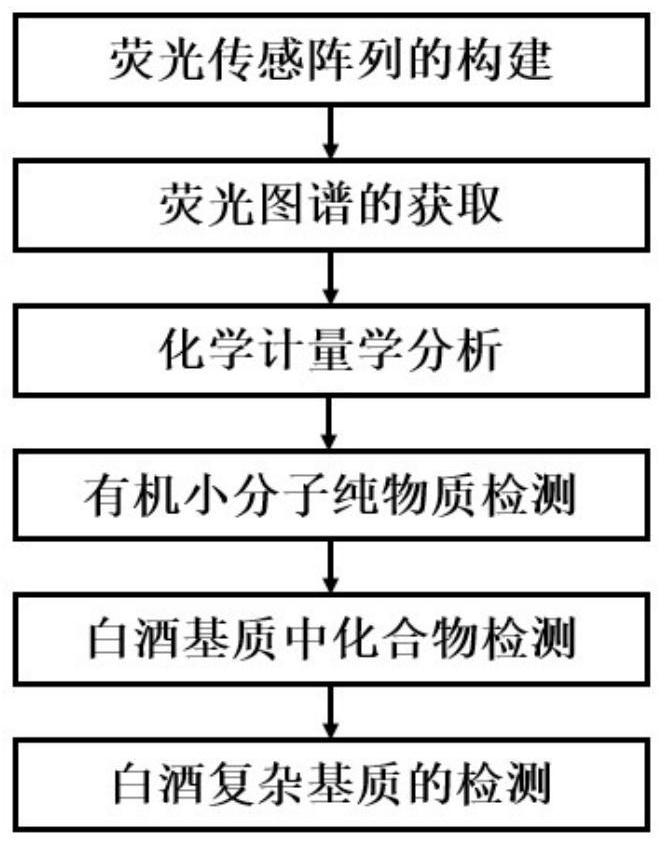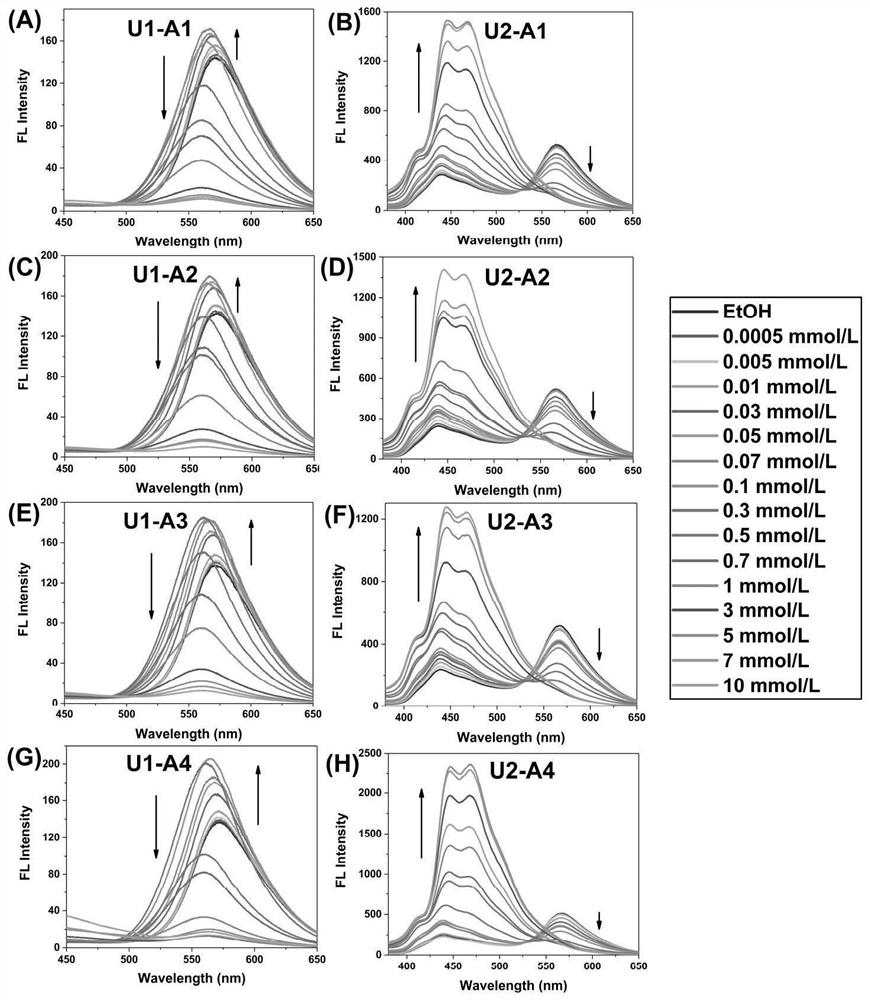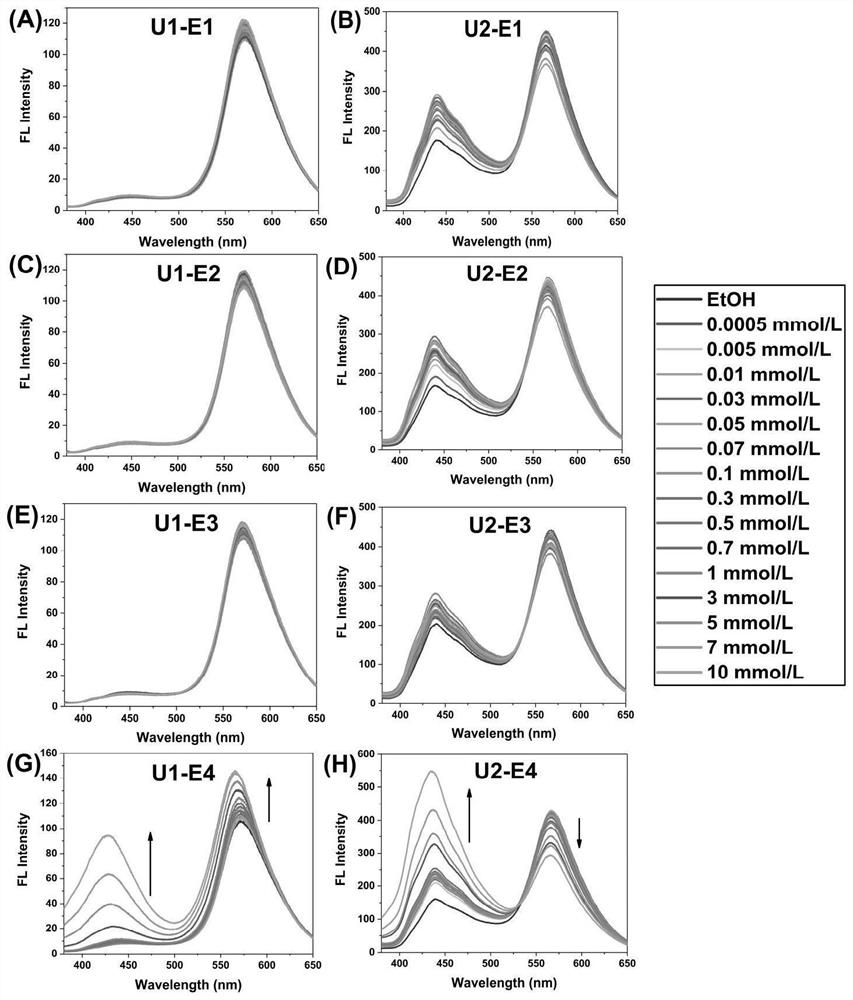Small organic molecule based on reaction of phenylenediamine and benzenediol, white spirit identification method and fluorescent array sensor
A small molecule, diphenol technology, applied in the field of organic matter identification and biomimetic sensors, can solve problems such as high cost and complicated operation, and achieve the effects of good linear relationship, easy availability of raw materials and low cost
- Summary
- Abstract
- Description
- Claims
- Application Information
AI Technical Summary
Problems solved by technology
Method used
Image
Examples
Embodiment 1
[0118] The dual-channel fluorescence array sensor constructed by the present invention can be used for qualitative distinction of 4 kinds of acids, 4 kinds of esters, 5 kinds of aldehydes and ketones, and quantitative detection of 4 kinds of acids, 1 kind of esters, and 5 kinds of aldehydes and ketones. It should be specified that the substances in the first sensing unit (U1) are: o-phenylenediamine + catechol + sodium carbonate, after mixing evenly, the identification system A (o-phenylenediamine 0.95mmol / L) is obtained , catechol 1.9mmol / L, sodium carbonate 0.651μmol / L); the substance in the second sensing unit (U2) is: 3,4-diaminotoluene + catechol + sodium carbonate, which can be identified System B (3,4-diaminotoluene 0.95mmol / L, catechol 1.9mmol / L, sodium carbonate 0.651μmol / L).
[0119]In this example, firstly, o-phenylenediamine and 3,4-diaminotoluene were prepared into an initial solution of 2 mmol / L, catechol was prepared into an initial solution of 4 mmol / L, and sod...
Embodiment 2
[0129] The dual-channel fluorescence array sensor constructed in this example can also identify organic small molecule compounds in 0.7 mmol / L liquor matrix on the basis of identifying the pure substance solutions of the above 13 organic small molecular compounds.
[0130] In this example, the organic small molecule compounds with different concentrations under each channel in Example 1 were replaced with organic small molecule compounds and dissolved in 3-fold diluted Luzhou Laojiao-60 Years (LZ-1) or diluted 3 At this time, the control solutions were 20 μL of Luzhou Laojiao-60 years diluted 3 times and 20 μL of Moutai Prince wine diluted 3 times.
[0131] In this example, 13 organic small molecule compounds were dissolved in 3-fold diluted Luzhou Laojiao-60 Years (LZ-1) or 3-fold diluted Moutai Prince Liquor (MTWZJ), and their original concentration was 3.5 mmol / L (excluding the corresponding small organic molecules contained in the liquor itself) to ensure that when 20 μL o...
Embodiment 3
[0136] The array sensor constructed in this example can also identify different kinds of Chinese liquor samples on the basis of identifying aldehydes and ketones, acids and esters. Liquor is rich in flavor substances, including aldehydes, ketones, acids, esters and other main flavor substances. Because the content and proportion of flavor substances contained in each kind of liquor are different, they constitute different aroma types and types of liquor.
[0137] In order to explore the practical application of the array sensor, 21 kinds of liquors from 4 main flavors in China are selected in this example, including 15 kinds of Luzhou-flavor liquors (they are Table 2 shows the specific information of Maotai-flavor liquor, one kind of Qing-flavor liquor and one kind of rice-flavor liquor.
[0138] Table 2 Specific information of 21 kinds of liquor
[0139]
[0140] For the identification of liquor, it is only necessary to replace the pure organic small molecule compound sol...
PUM
 Login to View More
Login to View More Abstract
Description
Claims
Application Information
 Login to View More
Login to View More - R&D
- Intellectual Property
- Life Sciences
- Materials
- Tech Scout
- Unparalleled Data Quality
- Higher Quality Content
- 60% Fewer Hallucinations
Browse by: Latest US Patents, China's latest patents, Technical Efficacy Thesaurus, Application Domain, Technology Topic, Popular Technical Reports.
© 2025 PatSnap. All rights reserved.Legal|Privacy policy|Modern Slavery Act Transparency Statement|Sitemap|About US| Contact US: help@patsnap.com



